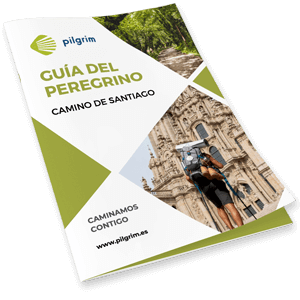The Compostela

Index
The Compostela. Origins
After the increase of pilgrimages during the 9th and 10th centuries, the need of certifying that pilgrims have done the itinerary had emerged following both religious and spiritual reasons.These two reasons have given privileges to pilgrims when it comes to receiving assistance or accommodation; this is how Compostela appear.
This is the way The Compostela was born. To substitute the former system that delivered a scallop as a accreditation of arriving to Santiago. This item was very easy to forge so finally was substituted by The Compostela. This change binds the pilgrim to walk all The Way stamping The Credential to certify they have visited and they have slept in the villages along the route.
What to do with The Compostela
You should give your card once you arrive at Santiago to get The Compostela. Nowadays The Compostela is known as the document that certifies that you have completed at least the last 100 kilometers (62 miles) on foot or the last 200 kilometers (124 miles) on bike. This document is issued by The Church Authorities after verifying the seals on it.
In addition they will ask us about the reason to walk The Way of St. James. Those reasons must be: religious, spirituals or for an internal search. There is in addition, another document called “in Memoriam” only requested for the relatives of those who perished on any of the tracks along The Way.
Perks of getting the Compostela (Misspelled sometimes as The Compostelana)
But first, we would like to remark a very common mistake among the pilgrims: an incorrect misspelling using The Compostelana instead The Compostela. The first one is totally inaccurate
As we have mentioned before, this document granted certain privileges to the pilgrims;When the Catholic Monarchs built in the 16th century the Pilgrims Hospital (Nowadays known as the Catholics Monarchs Hotel in the Obradoiro Sq), those pilgrims with The Compostela were available to rest there for free for three days
Despite the fact This Hotel is now a Luxurious Inn and hasn’t got anything to do with the previous activities of the Hospital, it is already stuck to the tradition of giving free breakfast and dinner to the first 10 pilgrims showing The Compostela.
How and Where to get The Compostela
How
To obtain The Compostela you must fulfill the following premises:
- The Pilgrimage must be due to both religious and spiritual reasons, or at least in the pursuit of finding any of them.
- Complying with the following requirements: 100 km / 62 mi on foot or on horse or 200 km / 124 mi for those on a bike.
- Collecting the required seals on The Pilgrim’s Credential. The seals are available in churches, monuments, hostels or even in some pubs and cafeterias
- At least two seals a day are required to certify the starting and ending point.
You can walk The Way on odd day, as the only important thing is the chronological and geographical order. The date of every journey must be clearly identified as well as the seals. This way the beginning and the end of the stages can be easily tracked.
Where
Pilgrim’s Office:
- Address:
- 33 Carretas St.
- PO BOX 15705 Santiago de Compostela
- A Coruña – SPAIN
- Teléfono: +34 981 568 846
- E-mail: oficinadelperegrino@catedraldesantiago.es
Schedule
From Easter to the 31st of October: opens from 08:00 am to 20:00 pm
In wintertime (From the 1st of November to Easter) opens from 10:00 am to 19:00 am *
The Welcome Pilgrim Office will be closed on the 25th of December (Christmas Day) and on the 1st of January (New Year Day)
* The closing time could be move forward in 60 minutes depending on the pilgrims number.What is written on The Compostela?
The Compostela contains the following text in Latin
“APITULUM hujus Almae Apostolicae et Metropolitanae Ecclesiae Compostellanae sigilli Altaris Beati Jacobi Apostoli custos, ut omnibus Fidelibus et Perigrinis ex toto terrarum Orbe, devotionis affectu vel voti cosa, ad limina Apostoli Nostri Hispaniarum Patroni ac Tutelaris SANCTI JACOBI convenientibus, authenticas visitationis litteras expediat, omni- bus et singulis praesentes inspecturis, notum facit : Dnum/Dnam____ (Versión latina del nombre del peregrino) Hoc sacratissimum Templum pietatis causa devote visitasse.
In quorum fidem praesentes litteras, sigillo ejusdem Sanctae Ecclesiae munitas, ei confero.
Datum Compostellae die____(día) mensis____(mes) anno Dni____ (año)
Canonicus Deputatus pro Peregrinis.”
Translation into English
The Council of this Apostolic Cathedral of Santiago de Compostela, guardian of the altar for the Apostle St James, to all pilgrims arrived from any spot on the Earth carrying a devotion attitude based on a promise or a vote, for those who walk towards the Grave of our Apostle, Patron Saint and Protector of Spain, certifies with this document that Mr/Ms……. has visited this sacred Temple with a Christian Sense. (pietatis causa)
In witness whereof I deliver this document seal with the stamp of this Holy Church
Delivered in Santiago de Compostela on the………. of………….. and on the Year of Our Lord …………..
The Canon Representative for Pilgrims .
Minimum distance to go in oder to obtain The Compostela
We’ll see now a map based on the different Ways with the strategy points that will help us to walk/ride the minimum distance required to get The Compostela.
On foot
The last 100 km / 62 mi required to obtain the final accreditation:

By bike
The last 200 km / 124 mi required to obtain the final accreditation:

Certificate of the Distance Walked / Ridden
In this document is recoded how many km / mi are walked/ ridden, the starting and ending date as well as the starting point of the Pilgrimage and the route chosen to arrive to Santiago.
This document is a little bit bigger than The Compostela. Reminds a parchment and it’ll be delivered to the pilgrim in the Pilgrims Welcome Office.
You can apply for it in the following mail certificadodedistancia@catedraldesantiago.es

The Other Compostelas
Apart from the official Compostela obtained to finish the Way, according to the requirements, there are other certificates delivered for ending connected Ways to The St James Way. These other routes are: The Lebaniego Way, The Savior Way, or The Kumano Way. They have their own documents to confirm the ending of the tour. Each document has its own denomination:
- The Liebaniega: Certificate obtained after ending The Lebaniego Way on foot or on a bike. It is delivered by The Church and will be dispatched only when all the required seals are stamped on it.
- The Salvadorana. This document is delivered at the very end of The Savior Way which connects both León and Oviedo Cathedrals It is issued by the Dean of The Oviedo’s Cathedral.
- Dual Pilgrim: It is maybe one of the most especial certificates in the world due to its peculiarity. To get this Dual Certification you must obtain first both The Compostela of The St James Way and the accreditation of the Kumano Way (Japanese Pilgrimage Route). This accreditation certificates the Pilgrims who have fulfilled both united routes in despite of their distant locations.

